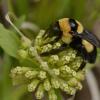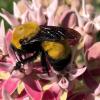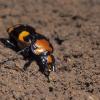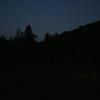
(Heteroptera: Saldidae)
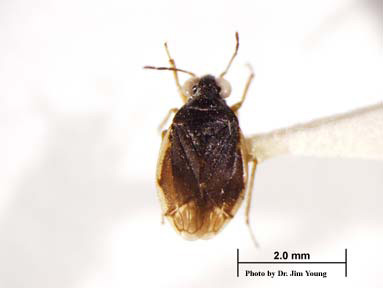
Photo by Jim Young from specimens in the Oregon State University Arthropod Collection. Please contact The Xerces Society for information on how to obtain permission to use this image.
Technical Description
Micracanthia fennica has an oval body shape of less then 3.5 mm in length. It has a general dark color with no apparent forked vein on the elongated middle portion of the forewing, the corium. The inner corium is usually without color or at most one pale apical spot (Merritt and Cummins, 1986 and Menke, 1979).
Two keys that will be useful for this species:
The Hemiptera section of Merritt R.W. and Cummins K.W. (eds.). 1986. An Introduction to the Aquatic Insects of North America. Third Edition.
The Saldidae section of Menke, A.E. (ed.). 1979. The Semiaquatic and Aquatic Hemiptera of California (Heteroptera: Hemiptera). Bulletin of the California Insect Survey, 21: 16-24.
We were unable to find information on specific documentation of M. fennica’s life history. Other Saldidae species lay eggs at the base of grass blades, insert their eggs into plant tissue, or glue them to other surfaces. Eggs for other studied Saldidae species range in size from .6 mm x .15 mm to 1.2 mm x .3 mm and are of elongate cylindrical shape. Eggs hatched in 7 to 12 days and nymphs then took 16 to 17 days to reach adulthood (Menke, 1979.
Other Saldidae species vary in overwintering habits. Many overwinter as adults, but some overwinter as eggs, and others are thought to be active during warm periods throughout the winter (Henry and Froeschner, 1988 and Menke, 1979).
As an adult M. fennica is a predator of small arthropods in riparian areas around springs and serves as food for other riparian arthropods (Lattin, 1995).
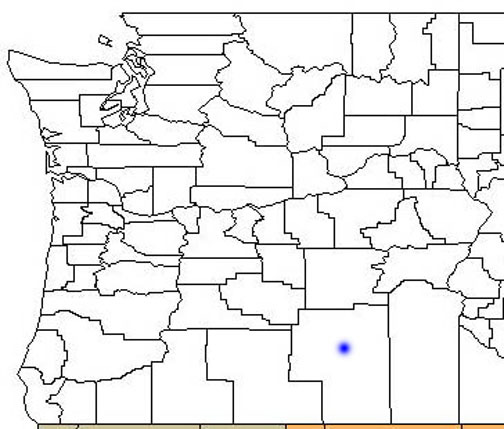
Historic distribution
M. fennica is a holarctic species that is widely distributed but in the western US, but there are some highly disjunct populations. The species is known from throughout sections of North America including parts of the Yukon, British Columbia, and the United States including Colorado, Idaho, Kansas, Massachusetts, New York, and Nebraska. It is also known from parts of Europe and Siberia (Danks and Downes, 1997).
Although widely distributed across North America it is has only been recorded from two sites in Oregon, both around Harney Lake in Harney County in the Burns district.
Within the OSU arthropod collection there is a total of three specimens from Oregon. Two specimens were taken south of Harney Lake, one a ½ mile south in May, 1956 and one a mile south in July, 1964. The third specimen is from twenty miles west of Malheur Lake in May, 1956, which places this specimen just north of Harney Lake (OSU Collection).
In 1995 Lattin noted that no numerical samplings had been made; however, he estimated that there would be no more than 100 individuals at the Harney Hotsprings complex (Lattin personal communication).
Current distribution
M. fennica’s current range in Oregon is unknown. It was only known to occur in Oregon at the sites around Harney Lake listed above, and we were not able to find any evidence of surveys conducted in the last forty years for this species. Due to the species very small size, limited range, and rarity there are no amateur recordings.
John D. Lattin, professor emeritus Oregon State University, collected a specimen in 1964 but he is not aware of anyone surveying for or finding M. fennica in recent years (Lattin personal communication).
Richard Roy, Malheur National Wildlife Refuge Biologist, is not aware of any surveys for M. fennica (Roy personal communication).
Darren Brumback, BLM Burns District Fisheries/Wildlife Program Lead, is not aware of any surveys for M. fennica (Brumback personal communication).
There have been insect surveys conducted at other hot springs complexes in Oregon; however, none of these surveys produced any incidental records of M. fennica, e.g., Borax Lake study and Hot Springs of Oregon survey (Furnish, et al. 2002 and Goedon, et al. 2003).
M. fennica is associated with riparian habitat (sometimes near thermal water) with sparse vegetation cover, presence of small-sized arthropod prey, and the absence of habitat disturbance. It occurs in the ground among the low vegetation surrounding the hot springs complex – not in the hot springs themselves. (Lattin, 1995)
Heritage Global Rank: G5
Heritage State Rank: Oregon (S1?)
John D. Lattin noted that there was heavy cattle grazing around the hot springs when he collected a specimen and he was concerned that the disturbance from this grazing was damaging the M. fennica habitat and adversely impacting the population. He also noted that there was flooding in later years (in the 1980’s and 1990’s there were several floods that put Harney Lake over its banks) that potentially inundated the springs near which M. fennica was known. (Lattin personal communication).
Richard Roy confirmed that some springs were inundated around Harney Lake during flooding; however there is a complex of springs extending around the southern part of Harney Lake to the west and it was not determined which specific springs were inundated. (Roy personal communication).
Due to its size and limited understanding of its specific life history it is difficult to determine what conservation steps are necessary for this species.
Avoid disturbance of M. fennica’s potential habitat (riparian areas surrounding thermal springs), take measures to maintain or enhance potential habitat, and undertake surveys within these habitats prior to management actions that may impact the habitat.
Surveys of its known historic Oregon location along with the surrounding hot spring complex are needed to determine if the species can be found again.
Danks, H.V. and J.A. Downes (eds.). 1997. Insects of the Yukon. Biological Survey of Canada (Terrestrial Arthropods). Ottawa, Canada. 1034 p.
Furnish, J.L., J.D. McIver, and M. Tieser. 2002. Algae and Invertebrates of a Great Basin Desert Hot Lake: A description of the Borax Lake ecosystem of southeastern Oregon.
Goedon, K., J.D. Lattin, C. VerLinden. 2003. Hot Springs Insects of Oregon. Corvallis, OR.
Henry, T.J. and R.C. Froeschner (eds.). 1988. Catalog of the Heteroptera, or True Bugs, of Canada and the Continental United States. E.J. Brill, New York, NY. 958 p.
Lattin, J.D. 1995. The Hemiptera: Heteroptera of the Columbia River Basin, Western United States. Contract report prepared for the U.S. Department of Agriculture, Forest Service; U.S. Department of the Interior, Bureau of Land Management, Upper Columbia River Basin Ecosystem Management Project. 56 p.
Menke, A.E. (ed.). 1979. The Semiaquatic and Aquatic Hemiptera of California (Heteroptera: Hemiptera). Bulletin of the California Insect Survey, 21: 16-24.
Merritt R.W. and K.W. Cummins (eds.). 1986. An Introduction to the Aquatic Insects of North America. Third Edition. Kendall/Hunt Publishing, Dubuque, IA. 862 p.
Oregon State University Arthropod Collection. Dr. Christopher J. Marshall, Collection Manager and Assistant Curator. Corvallis, OR. Species ID # 000083700 and 000083982.
Additional Resources
NatureServe. 2007. NatureServe Explorer: An online encyclopedia of life [web application]. Version 6.2. NatureServe, Arlington, Virginia.
Profile prepared by The Xerces Society for Invertebrate Conservation

